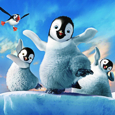Warner Bros. Pictures (November 18 2011), Warner Home Video (March 13 2011), 1 Blu-ray and 1 DVD, 99 mins plus supplements, 1080p high-definition 2.40:1 widescreen, DTS-HD Master Audio 5.1, Rated PG, Retail: $35.99
Storyboard:
It’s “Son Of Happy Feet” as first film’s hero Mumble’s kid, Erik, gets into an “all-new” adventure.

The Sweatbox Review:
If, as it has again been recently suggested, Edgar Rice Burroughs’ A Princess Of Mars had beaten Walt Disney’s Snow White And The Seven Dwarfs to the screen as the movies’ first animated feature film, I wonder if we would have subsequently enjoyed a near-decade of animated sci-fi adventures rather than fairytales and singing animal movies? Certainly the drawn animated medium would have suited the pulp-novel’s style of illustrations, which later found more of a home in horror and thrill comics. But Snow White was the scene-setter, just as Toy Story, although it can’t really lay claim to have re-invented the form, dictated that all following computer animated movies should be knockabout contemporary comedies.
There have, of course, been exceptions to both techniques over the years, with sci-fi particularly making a decent showing in the CG realm, but knockabout comedies it has mostly been until the last few years, when it suddenly seamed the creators of these kinds of films sort of lost the plot. An emphasis on crazy, out-there concepts emerged: cars that drove themselves, self-made robots, even the original Ice Age was more off-kilter to what we usually expected in animated film. It was great to see ideas broadening out from the norm (more recently, Rio proved to be the past year’s “what the…?” idea), but in a couple of cases it did feel that some of these films were pitching themselves as “different” merely for the sake of it.
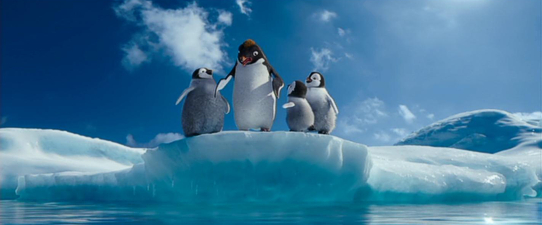
Love it or hate it, Happy Feet clearly divided audiences’ feelings back when it was released in 2006. Thanks to the mega-success of the documentary March Of The Penguins, the cute little birds were big business when it came to the movies, and a slew of animated films (co-incidentally in production before March’s stomping across the box-office charts but released afterward) cleaned up. Apart from Sony Animation’s own penguin “mockumentary” Surf’s Up, DreamWorks got in on the act with their Madagascar spin-offs, while Happy Feet’s phenomenal success even propelled it to walk away with an Oscar for Best Animated Feature (fairly or unfairly, depending how you look at it, beating the mighty Pixar’s Cars to the finish line).
That was a decision that rankled many in the animation community, to which the movie wasn’t really seen as “animated” due to it using the motion-capture process. This isn’t a totally fair assumption to make, since any animated film, mo-cap or otherwise, contains a degree of keyframed augmentation, but the argument was that Happy Feet’s fault was in using the process to create a hoard of dancing penguins, the very aspect the film’s marketing promoted so much. While I didn’t have a problem with the process, specifically, I did have issues with the unnatural way the animals moved, though this was just one aspect in which the film sparked debate.
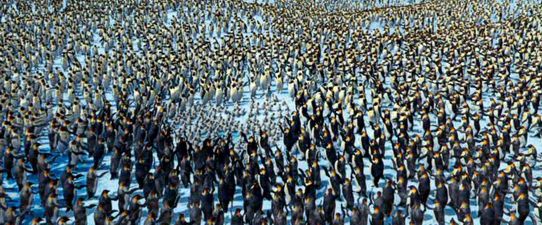
Happy Feet evenly split audiences into one half that loved the film and what it said, and those who felt somewhat betrayed that they were sold one movie – a fun dancing penguins caper – and came out of another – when the warmhearted musical comedy penguin movie turns halfway through into something much darker and unexpected: an environmental issues appeal. And once that messaging begins, Happy Feet lost track and became a real chore to sit through, the message – albeit one of genuine concern – heavy handed and, one must point out, not actually too clear in its ambitions (if director George Miller had really wanted to hammer it home, he would have killed off a character or two).
But even by the end of the first movie the dancing penguin shtick had become old hat, and a final Berkeley-esque number sealed the deal for me: I could quite happily never see another dancing penguin again and it would be too soon. Well, here we are again and, yes, even with a six-year gap it’s too soon, not only for me, it seems, but for general audiences too, who failed to make Happy Feet Two the kind of hit enjoyed by the first outing. Oh, how times have changed, and in the intervening years it seems penguins have lost a little of their movie allure, with even the Jim Carrey-headlining Mr Popper’s Penguins only managing a so-so showing at the box office last year too.
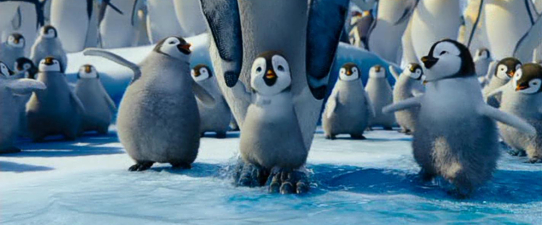
Perhaps if Happy Feet Two had attempted to be more than to just repeat the first film’s basic storyline audiences might have responded more positively. The film picks up (after a Seussian-mixed-with-Lion King opening narration that feels old already) with yet another Berkeley-esque dance ensemble, during which I personally found the semi-sexualization of some young penguins to be a step too far, and just as the dancing Mumble had difficulty fitting it with his singing companions, so here does little Erik find himself unable to dance in the penguins now singing and dancing world. But instead of following (the now grown up) Mumble’s progress as a character, having a new young penguin substitute means the cute factor is covered, which I presume the filmmakers were relying on for drawing in a crowd.
The result simply feels as if we’re watching the first film again, although at least the environmental slants are present and correct right from up front. Not that what happens is actually very clear: Happy Feet Two is again what is basically an adult message movie dressed up as a kids penguin caper, and so although grown ups will understand the effects of the melting icecaps and the tsunamis that can be created if a chunk of ice breaks off, these things might well be unfamiliar concepts to younger kids, who will no doubt keep wondering why certain things are happening. This applies to the plot angle as well: characters walk off or disappear just so they’re not around when they shouldn’t be for a story point, and at other times just because characters are not in frame, it’s suggested they don’t know what’s happening just around the corner.
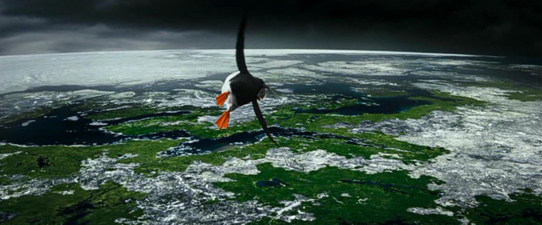
For instance, early on, a huge tsunami wave (so big that it moves icebergs as it washes along the water) crashes against the penguins’ icy landmass. Witnessed by Robin Williams’ Ramon, it is initially a surprise that the force doesn’t kill him outright, but an even greater one that this deluge of water does not affect, or is seen or referenced by, Erik and his pair of penguin buddies, who wander into the scene in the very next shot and so must have been in the vicinity when the wave hit. There are odd choices, too: when a group of krill are eaten by blue whales, their collective shape takes on the appearance of a skull. Yes, this is a widely accepted indication of “death”, but it’s just another example of ideas and notions overcoming a valid reason to be here rather than feeling seamlessly woven in.
And the film wants its cake and to eat it too: running side by side the real life, all-important environmental messaging is the apparent introduction of a completely fantasy element, Sven, a “penguin” that can fly. As voiced by Hank Azaria, who has fast become something of a serial animation vocalist filling previous spaces filled by the likes of Tim Curry, John Goodman and Patrick Warburton, memories of Bartok, the magnificent albino bat in Don Bluth’s Anastasia may come flooding back: Sven is to Azaria what Shrek’s Donkey was to Eddie Murphy after he had voiced Mushu in Disney’s Mulan.

Ultimately, there’s no enough originality here not only Azaria’s characterization but in the entire movie to stave off a huge sense of déjà vu (or an incredible shrinking bird: when Sven’s true origins are revealed, he seems to become half the sized bird he used to be).
If audiences had wanted to repeat their Happy Feet experience, they could have quite as easily inserted their original DVDs and watched the first movie over again, which does seem to have been what happened here. We’re at a point in the evolvement of cinema in general where audiences have become jaded towards sequels: sure, they’re a fun way to expand a story and enjoy more time with favorite characters, but I think we’d all rather return to a beloved original than see a tired re-run. I don’t even get the title! Happy Feet Two? What’s with the plural wordage, instead of a respectable II or plain and simple numerical 2? Is it supposed to refer to Mumble’s son’s having happy feet too, in which case the title should be Happy Feet Too and would work much better anyway!?

Naturally there are some good things to be said: Brad Pitt and Matt Damon steal the show as occasional supporting krill characters Will and Bill that, in the same way as Scrat in the Ice Ages or Rick Moranis and Dave Thomas’ moose in the Brother Bear films, come and go without much consequence to the main story arc, even if they do get the best lines: “I’m one in a krillion!” and “Goodbye, krill world” fed my appetite for puns more than adequately. But, confused and confusing, the rest of Happy Feet Two just doesn’t measure up, being full of clichéd sequences, familiar feeling characters, tired dialogue and situations, and simply boring moviemaking. There’s even a near-cannibalistic scene where a group of hungry skua birds attempt to munch on their non-flying cousins!
The movie even dares to end by showcasing its Warner Bros.-sponsored links, with a classic Looney Tunes post-credit title card featuring Sven, whom I presume we are supposed to now love even though he has been discounted and ashamed as a fraud earlier on. Needless to say, attempting a Looney Tunes connection is pretty crass: the film is nowhere near being in that league and simply doesn’t deserve to be mentioned in the same breath as those miniature masterpieces of animation. Still, at least this movie does end – eventually, and quite suddenly at that – and, hopefully (while I wouldn’t wish this on the real wildlife, of course), if global warming is good for something it’ll be in wiping out the rest of the cast too, so that we won’t have to endure any more movies like Happy Feet Two.

Is This Thing Loaded?
Ugh! What a horrible looking menu system these discs have! A Blu-ray and DVD combo pack (a movie-only DVD, movie-only Blu-ray, and Blu-ray 3D combo edition with everything in are also available), the menus here look like they were thrown together in a home DVD package, with the most basic of icons (a house to indicate the Main Menu, a globe for Languages, etc) offering nothing in the way of a movie theme – I hope this isn’t Warners’ new standard of instantly interchangeable international menus, since they’re as insipid as they come! Previews play on start up for Blu-ray 3D and Happy Feet Two: The Videogame.
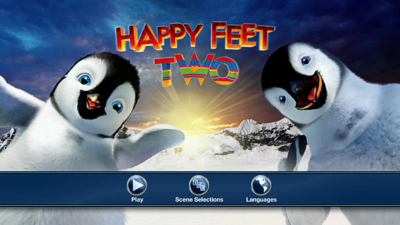
As with the first film’s initial DVD, Happy Feet Two doesn’t come loaded with a tremendous amount of behind the scenes supplements, but there is a decent enough package of small nuggets that offer some value. While I’d have again welcomed a commentary track from co-writer and director George Miller, to hopefully explain some of the nuts thinking behind some of the more ambiguous choices, the closest we get to a look at the production is a peek behind the microphone for a visit down under to see The Amazing Voices Of Happy Feet Two (4:50) in action. This brief look shows the obvious fun the cast had in the studio, where they recorded their lines as a group instead of individually, but it’s unfortunate the spirit doesn’t carry over into the film.
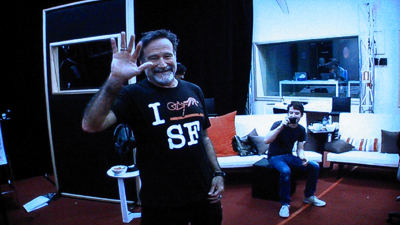
If you wanted to know more about the film’s animal characters, Helping Penguins And Pals (11:50) checks out Antarctica with Lil’ P-Nut, as the young voice of Erik’s pal Atticus leads us on a tour of the south pole to explore the world of penguins, krill, seals and blue whales amongst others. At just under twelve minutes, this naturally doesn’t have the depth of a dedicated nature program, but as a primer for kids it very nicely does the job, and there’s a look at how we can environmental organizations to preserve these creatures in their natural habit (there now, you knew there had to be a green angle, but it’s again done nicely).
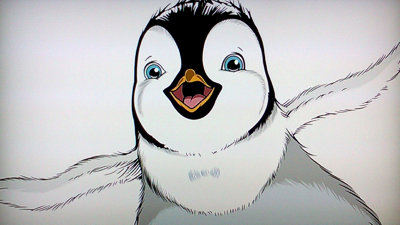
The five-minute How To Draw A Penguin offers to show us how to create a cartoon version of “your favorite adorable penguin” Erik (actually, baby Mumble was cuter, not that there’s much in it), even though this is a CG feature and none of the characters are hand drawn. Moreover, this is less a tutorial and more just a clip of watching the storyboard supervisor draw the character in super-quick time, even if he does show the basic steps. Also odd is Running With Boadicea (3:10), a random look at one of the supporting characters, while P!nk’s New Song (1:55) visits Alecia (P!nk) Moore, taking over from the first film’s Brittany Murphy, to find out the story behind a new track written for the movie, which is also selectable as one of three Sing-Along clips, running over eight minutes combined.

Also an option is the Happy Feet Two Movie App, which jumps on Disney’s Second Screen concept to offer up “a truly interactive experience, including sing-alongs, dancing penguins and more”. Unfortunately, unlike Disney’s Mac and PC-ready opportunities, Warners’ app is Apple-only, meaning you need an iPad, iPhone or iPod to participate, but I’m somewhat against this concept anyway when purchasing a full-featured (and full-priced!) disc should mean you get all this kind of content on the disc (and as Blu-ray’s capabilities promised) rather than have to own another device and run it. Yes, it’s “free”, but the question of what happens when a title’s popularity means the content is removed offline is raised again, not that there seems to be that much here to worry about.

Finally offered is the one sole reason the set may be of interest, to anyone (if you can find it at a good price, it’s worth picking up a used copy just for this): the inclusion of a new Looney Tunes short I Tawt I Taw A Puddy Tat brings to life not only to Tweety Pie’s signature line but also to a classic recording from animation’s golden age. With the popularity of cartoon characters in the 1930s and 40s, it wasn’t unheard of for recording artists to dedicate songs to their favorite animated stars. Mickey Mouse benefited enormously from sheet music and radio airplay of songs paying tribute to him during his 1930s heyday, while in the following years the likes of Popeye The Sailor and Woody Woodpecker (as voiced by Mel Blanc) had a big hit with their theme songs, among others.
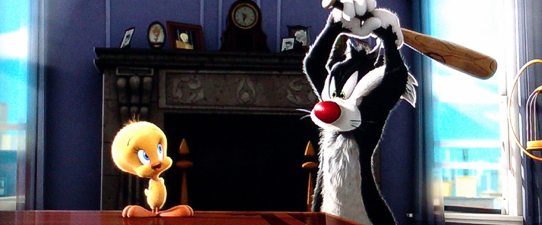
Blanc again featured on a recording of I Tawt I Taw A Puddy Tat, a 78rpm disc released in 1950-51, scoring another hit similar to his Woody Woodpecker Song. Describing the average elements of a typical Tweety and Sylvester cartoon of the era, the song has always been a personal favorite of mine among a selection of such recordings, and this 2011 short (which played theatrically with Happy Feet Two) uniquely combines old and new. Using Blanc’s vintage vocals on the soundtrack, the song has been augmented with a newly recorded orchestra for full fidelity, while the animation has been updated to state of the art CGI. Quite why incorporating the song into a short had never been done before can only be because it’s such an obvious thing to do, but no matter: it’s here now, and it actually works very, very well.
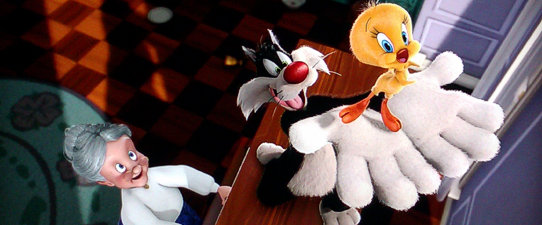
If there are any characters that do seem to make the transition from hand-drawn to computer animation, then it’s those in the Looney Tunes stable, as the previously unreleased short Marvin The Martian In The Third Dimension proved (it’s available now on the Looney Tunes Platinum Collection), and the development of true squash and stretch fluidity in the technique means the characters move with authentic zip to their actions. The detailing may take some getting used to (Sylvester, although still a cartoon cat, has real, quite scraggly fur, and I wasn’t sure I liked the texture of his nose), but the vintage recording of Blanc (joined by June Foray here) is authentically grounded in the classic era. Think of it as purchasing a great cartoon and getting a dancing penguin movie as an extra!
Case Study:
Available as both a 3D combo and the two-disc Blu-ray and DVD pack under review here, Happy Feet Two follows the usual route in terms of its packaging, from the slimline, eco-friendly (of course) BD case and glossy embossed slipcover that replicates the sleeve artwork. Included inside are inserts for the film’s video game and movie app, plus a code for a Happy Feet Two UltraViolet Digital Copy (not playable in iTunes); UltraViolet being Warners’ snazzy but silly marketing speak for a downloadable version of the film (see, it’s “included” in the package, but it’s not physically here: an invisible edition that can only be seen under the special light of a digital code). Yeah, dumb, but the term seems to be sticking, and they also missed a trick by not listing the Looney Tunes short anywhere on the package either.
Ink And Paint:
Well, if there’s any element to Happy Feet Two’s debut in high-definition on Blu-ray that can not be faulted, then it’s the superlative images. However the penguins’ movements are achieved, the sheer size and spectacle of seeing thousands of these birds moving in synchronization is impressive, even if the effect does wear off because it’s repeated so many times, and it’s sharply and consistently reproduced here. Being a digitally animated film, grain isn’t an issue, obviously, although I didn’t feel it quite matched the super-sharpness and detail of a Pixar or DreamWorks feature, quite possibly down to the less detailed, but no less textured, vast expanse of snowy whiteness.
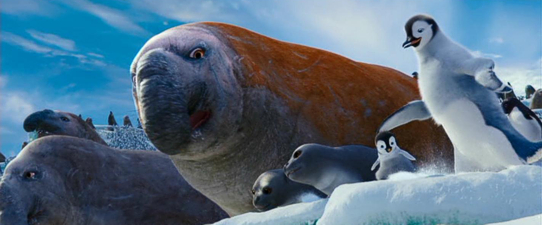
Even better is director Matt O’Callaghan’s Tweety and Sylvester short I Tawt I Taw A Puddy Tat, which is about as sharp as I think I’ve seen animation get on Blu-ray. It is also included on the 3D edition, and obviously intended to work in that format, but there were genuinely a couple of times I thought I was going to be spattered with Sylvester’s dribbling even in this “flat” showing, such is the level of depth and detail in the toon. Delightfully hyper violent in a Roger Rabbit Something’s Cookin’ (at one point Sylvester is visibly run over by a truck) kind of way, this is well worth picking up a used copy of the disc for.
Scratch Tracks:
Once again mixing in celebrity voices with Moulin Rouge!-styled covers of pop classics, Happy Feet Two sounds as good as expected, meaning it’s really the vocal cast that kind of let things down. Pitt and Damon, as noted above, come out of it best, but Elijah Wood’s Mumble has some odd performance choices and Williams gets more screentime with the additional role of Lovelace (who doesn’t sound too different to Ramon!), while Azaria’s Bartok clone Sven is also too familiar. DreamWorks regular John Powell composes an adequate score between the singing, but it’s not his best work, though there’s no real faulting the DTS reproduction even if it is just a 5.1 as opposed to a 7.1 mix. English, French, Spanish and Portuguese dubs and subs are bundled in.
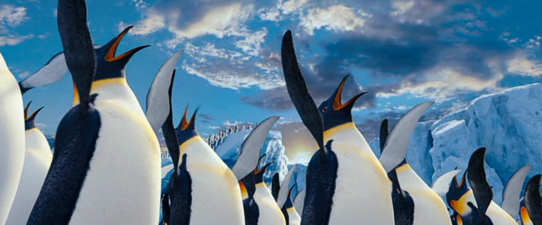
Final Cut:
If you’ve never seen an upset animated penguin pee right on screen, or want to see a skua bird crap on a penguin’s face, then Happy Feet Two is the movie for you! It isn’t as disappointing as Cars 2 was from Pixar, but then we expect more from that powerhouse of quality animation to begin with. When they don’t meet expectations, we feel a little let down, but with only the original, split-opinion Happy Feet behind them – and this being a sequel anyway – there just isn’t that kind of expectation from the fledgling Dr D Studios crew here, which turns out to be helpful since all we get is, basically, a boring and tedious version of the first film all over again.
But audiences are not stupid, and this is something they seemed to have sniffed out pretty early on, going by the numbers that stayed away from the theatrical release, and it’ll be interesting to see if the same applies to the “home video babysitter” market that these films appeal to – my advice: just run the first film again (really, pick any scene from both and I challenge anyone to be able to make a meaningful distinction). Although those that did enjoy the first film might like to enjoy more time with Mumble and company, that really is all you get: the first film all over again.
 | ||
 |



